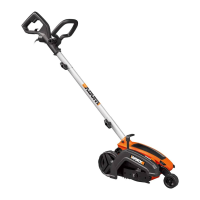10
ASSEMBLY & OPERATION
Action Figure
Assembly
Assembling the Shaft See Fig. A
Assembling the Auxiliary Handle See Fig. B
Attaching the Extension Cord
See Fig. C1
& C2
Operation
Setting to the edging position See Fig. D1
Edging
See Fig. D2
&D3
Adjusting cut depth
See Fig. E1
& E2
Setting to the trenching/
landscaping position
See Fig. F
Trenching and landscaping
operation
Removing and attaching the
blade
See Fig. G1
& G2
OPERATION INSTRUCTION
NOTE: The edger is a major appliance and
should not be operated simultaneously
with other major appliances on the same
household circuit.
WARNING: Make sure that other
persons and pets are at least 100
feet away.
EDGING
1. Before starting the edger, line up the tool
so the edge guide rests against the edge
of the paved surface. Both rear wheels
should be on the paved surface when
edging. (See Fig. D2)
2. To avoid kickback of edger, tilt the handle
down so the blade is above the ground
(See Fig. D3).
3. Turn switch ON and allow blade to spin
without moving tool.
4. Slowly lift the handle to lower the blade,
finding the edge of the paved surface
and start edging. Then move tool forward
slowly along edge of paved surface,
keeping the edge guide pressed lightly
against the pavement edge. For the
first edging each season, it is best to
move forward slowly because grass is
thickest then. Subsequent edging will be
completed more rapidly. If the tool slows
down, back it up an inch or two until the
blade comes up to normal speed. During
edging some sparks may be generated
from hitting stones. This is normal. Do not
attempt to edge when the grass or soil is
wet or moist—for electrical safety and to
prevent clogging of the blade chamber.
If you must edge under conditions that
cause the blade chamber to become
clogged, release trigger, wait for blade to
come to complete stop! UNPLUG TOOL!
open door and remove clogged material
with a stick. To continue to operate the
tool in a clogged condition will seriously
overload the motor.
CAUTION: Do not attempt to unclog
the blade chamber by dropping or
tapping the tool on the ground. This can
damage the unit. Keep hands clear of
edge guide and blade when cleaning as
these wear to a very sharp point during
edging.
TRENCHING AND LANDSCAPING
OPERATION
The Edger can also be used for Trenching. The
blade will leave a small trench for placing
Wire underground.
Because of the direction of the Blade rotation
the Edger can kickback towards the operator
if it hits an obstruction such as thick, matted
grass. Keep a firm grasp on the Handle,
especially when trenching in thick, matted
material.
The Edger can be used in Landscaping
applications, including cutting along the edges
of flower and shrubbery beds, around trees,
and cutting in preparation for sod removal.
Before trenching, inspect and ensure there are
no exposed or buried cables, pipes or other
objects that may create a hazard or interfere

